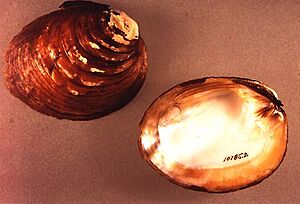White warty-back pearly mussel facts for kids
Quick facts for kids White warty-back pearly mussel |
|
|---|---|
 |
|
| Conservation status | |
| Scientific classification | |
| Genus: |
Plethobasus
|
| Species: |
cicatricosus
|
| Synonyms | |
|
|
The white warty-back pearly mussel is a special kind of freshwater mussel. It is also called the white wartyback. This mussel belongs to a family known as Unionidae, which are river mussels.
This amazing creature once lived in many rivers across the United States. It was found in the Ohio River, Cumberland River, and Tennessee River systems. Sadly, its numbers have dropped a lot. It is now very close to disappearing forever. Because of this, the United States government lists it as an endangered species. This means it needs special protection to survive.
What Does the White Wartyback Look Like?
This mussel has a shell that is yellow-green or yellow-brown. Inside, the shell has a shiny, white lining. This lining is called the nacre. It can sometimes look like a rainbow, which is called iridescent.
One cool feature of its shell is a line of bumps. These bumps are called tubercles. They run along one edge of the shell.
Where Did This Mussel Live?
The white wartyback mussel liked to live in the main parts of big rivers. It used to be found in many states. These included Alabama, Illinois, Indiana, Kentucky, Ohio, Tennessee, and West Virginia.
Today, it has disappeared from most of these places. This is called being extirpated. It might still be in Tennessee and Alabama. Specifically, it might be in the main flow of the Tennessee River. However, no one has seen a live white wartyback since 1997.
What Are the Plans to Help It?
Scientists and conservationists are working hard to save this mussel. If they find a group of these mussels that can still have babies, they have a plan. They want to bring the white wartyback back to some rivers. These rivers are the French Broad River and the Holston River in Tennessee.
Right now, there are no live white wartyback mussels in labs. There are also none in special places that raise animals. This makes saving them even harder. Everyone hopes to find a living population soon.


